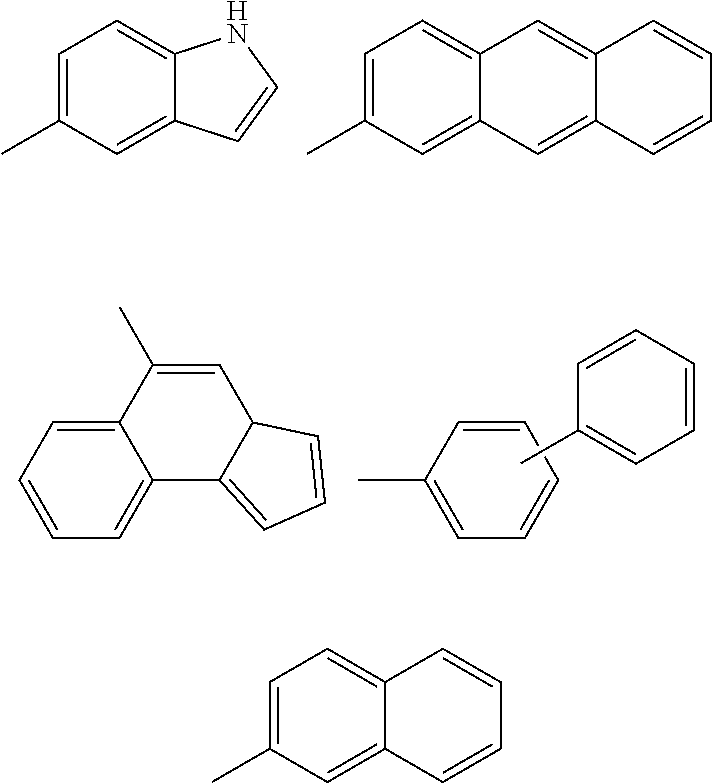Inhibitors of protein tyrosine kinase activity
a technology of protein tyrosine kinase and inhibitors, which is applied in the direction of biocide, group 5/15 element organic compounds, drug compositions, etc., can solve the problems of limiting this approach, affecting the effect of vegf inhibitors as cancer treatments, vision loss, etc., and achieves the effects of inhibiting protein tyrosine kinase activity, inhibiting kinase activity, and inhibiting protein tyrosin
- Summary
- Abstract
- Description
- Claims
- Application Information
AI Technical Summary
Benefits of technology
Problems solved by technology
Method used
Image
Examples
example 179
1-(3-(Dimethylphosphoryl)phenyl)-3-(3-fluoro-4-(2-(5-((2-methoxyethylamino)methyl)pyridin-2-yl)thieno[3,2-b]pyridin-7-yloxy)phenyl)urea (289)
Step 1. 1-(dimethylphosphoryl)-3-nitrobenzene (286)
[0312]To a solution of 1-iodo-3-nitrobenzene (2.4 g, 9.6 mmol) in dry 1,4-dioxane (24 ml) in a pressure bottle under nitrogen at room temperature was added dimethylphosphine oxide [WO 2005 / 009348] (1.5 g, 19.2 mmol), Pd2(dba)3 (0.44 g, 0.48 mmol), Xantphos (0.56 g, 0.96 mmol) and cesium cabonate (4.38 g, 13.5 mmol). The mixture was degassed by bubbling nitrogen into the solution for 10 min. The pressure bottle was closed and heated at 90° C. for 3 h. The solvent was removed under reduced pressure and the residue was purified via Biotage (linear gradient 0-20%, methanol / ethyl acetate; 25M column) to afford title compound 286 as a brown solid (1.52 g, 7.63 mmol, 79%). MS (m / z): 200.1 (M+H).
Step 2. 3-(dimethylphosphoryl)aniline (287)
[0313]To a solution of compound 286 (1.5 g, 7.5 mmol) in methanol...
example 180
1-(4-(Dimethylphosphoryl)phenyl)-3-(3-fluoro-4-(2-(5-((2-methoxyethylamino)methyl)pyridin-2-yl)thieno[3,2-b]pyridin-7-yloxy)phenyl)urea (290)
[0316]Compound 290 was obtained by following the procedures described above for the compound 289 (Example 179). Characterization of compound 290 and compounds 295-300 are provided in the Table 1.
TABLE 1CpdExSTRUCTURECHARACTERIZATION290180
1-(4-(dimethylphosphoryl)phenyl)-3-(3-fluoro-4-(2-(5- ((2-methoxyethylamino)methyl)pyridin-2-yl)thieno[3,2- b]pyridin-7-yloxy)phenyl)urea1H NMR (400 MHz, DMSO-d6) δ (ppm); 9.38 (s, 1H), 9.29 (s, 1H), 8.57 (s, 1H), 8.52 (d, J = 5.6 Hz, 1H), 8.32 (s, 1H), 8.23 (d, J = 8.0 Hz, 1H), 7.89 (d, J = 6.0 Hz, 1H), 7.77 (d, J = 13.4 Hz, 1H), 7.70-7.65 (m, 2H), 7.62- 7.59 (m, 2H), 7.46 (t, J = 8.8 Hz, 1H), 7.28 (d, J = 10.0 Hz, 1H), 6.67 (d, J = 5.6 Hz, 1H), 3.78 (s, 2H), 3.40 (t, J = 5.8 Hz, 2H), 3.24 (s, 3H), 2.65 (t, J = 5.8 Hz, 2H), 1.61 (d, J = 13.2 Hz, 6H), one NH is not seen in the spectrum. MS (m / z): 620.3 (M + H)...
example 202
Step 1. tert-Butyl(2-(7-(2-fluoro-4-(3-isopropylureido)phenoxy)thieno[3,2-b]pyridin-2-yl)-1-methyl-1H-imidazol-5-yl)methyl(2-methoxyethyl)carbamate (314)
[0317]The reaction mixture of aniline 46 (200 mg, 0.379 mmol) and 2-isocyanatopropane (64.5 mg, 0.758 mmol) was heated to 100° C. for 15 min in a microwave reactor. The reaction mixture was loaded directly into Biotage (Silicycle, HR, 12 g column, 50-100% EA / Hexane, then MeOH / EA, 0-20%). The collected fractions afforded the desired product 314 (150 mg, 0.245 mmol, 64.6% yield) as a white solid. MS: 613(MH)+, very weak signal.
Step 2. 1-(3-Fluoro-4-(2-(5-((2-methoxyethylamino)methyl)-1-methyl-1H-imidazol-2-yl)thieno[3,2-b]pyridin-7-yloxy)phenyl)-3-isopropylurea (315)
[0318]The solution of urea 314 (150 mg, 0.245 mmol) and TFA (1 mL, 12.98 mmol) in DCM (20 mL) was stirred 4 hr at room temperature and concentrated. The residue was partitioned between EtOAc / NaHCO3 sat. solution. The solid was collected by filtration and combined with orga...
PUM
| Property | Measurement | Unit |
|---|---|---|
| enantiomeric excess | aaaaa | aaaaa |
| temperature | aaaaa | aaaaa |
| temperature | aaaaa | aaaaa |
Abstract
Description
Claims
Application Information
 Login to View More
Login to View More - R&D
- Intellectual Property
- Life Sciences
- Materials
- Tech Scout
- Unparalleled Data Quality
- Higher Quality Content
- 60% Fewer Hallucinations
Browse by: Latest US Patents, China's latest patents, Technical Efficacy Thesaurus, Application Domain, Technology Topic, Popular Technical Reports.
© 2025 PatSnap. All rights reserved.Legal|Privacy policy|Modern Slavery Act Transparency Statement|Sitemap|About US| Contact US: help@patsnap.com



